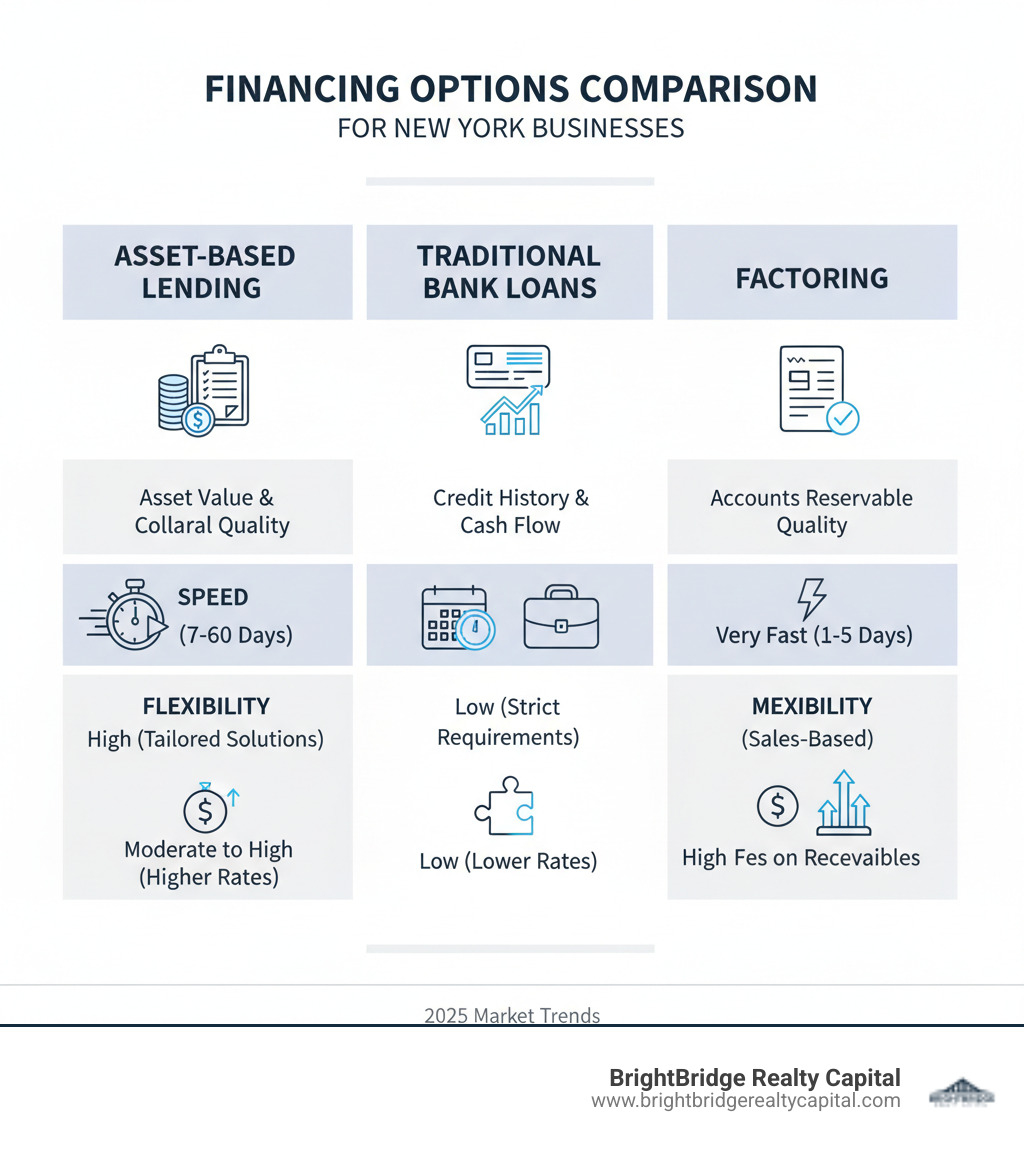New York's Secret Weapon: Understanding Asset-Based Lending

Opening Capital in the Empire State
Asset based lending New York is a financing solution where businesses or investors secure loans using tangible assets—like receivables, inventory, or property—as collateral. Instead of focusing solely on credit scores, it leverages what you own, offering faster funding (often 7-14 days), higher borrowing capacity, and fewer covenants than traditional bank loans.
Quick Answer: What You Need to Know
- What it is: Loans secured by your business or property assets
- Common collateral: Receivables, inventory, equipment, real estate
- Typical loan size: $1M to $20M+ (varies by lender)
- Speed: 7-60 days to funding
- Best for: Growing businesses, real estate investors, seasonal companies, turnarounds
- Key advantage: Access capital based on asset value, not just credit history
New York's dynamic economy, with a $3.51 trillion housing market and property rates that jumped 15.5% in early 2025, creates immense opportunities. However, businesses and investors need to move fast. Traditional bank loans, with their lengthy approval times, stringent credit requirements, and focus on historical cash flow, often can't keep up with the pace of business in the five boroughs and beyond. Post-pandemic credit tightening has made banks even more risk-averse, frequently declining loans for businesses with minor credit blemishes or those in rapidly evolving industries, despite holding valuable assets.
Asset-based lending (ABL) provides the solution. It allows you to leverage your existing assets to open up capital quickly. Whether you're a manufacturer in the Brooklyn Navy Yard, a distributor in the Bronx, or a real estate investor eyeing a property in Buffalo, ABL offers the financial flexibility to act when it matters most.
Why ABL is gaining traction in New York:
- Speed matters: In competitive markets like New York City real estate, the ability to close a deal in days, not months, is a decisive advantage that can mean the difference between acquiring a prime asset and losing it to a faster-moving competitor.
- Asset-rich, cash-poor: This classic scenario is common in New York. A business might have millions in high-quality inventory and receivables but show a historical loss due to a recent expansion or a single bad quarter. ABL helps these companies unlock the value on their balance sheet when traditional lenders only see the red ink on the income statement.
- Flexibility: ABL structures are tailored to your business cycle. A revolving line of credit can expand to accommodate a large inventory purchase for the holiday season and then contract as sales are made, while a bridge loan can secure a new property before an old one is sold. This adaptability is key in a fluctuating economic environment.
I'm Daniel Lopez, a loan officer at BrightBridge Realty Capital. I specialize in helping New York clients use asset based lending New York for real estate acquisitions and growth. My goal is to simplify the process, ensuring you can make confident decisions and seize opportunities quickly.

In the sections ahead, we'll break down how ABL works in New York, what assets qualify, and if it's the right fit for your business.
Asset based lending New York terminology:
How Asset Based Lending in New York Works: A Practical Guide
With asset based lending New York, you turn the value of your assets—invoices, inventory, equipment, or property—into working capital. The value of your collateral drives how much you can borrow, making it a powerful tool for asset-rich businesses and investors who need capital quickly.

Eligible Assets for Collateral
Asset based lending New York accepts a much wider range of assets than traditional financing. Common collateral includes:
- Accounts Receivable: Lenders typically advance 75-90% of the value of eligible invoices. An "eligible" invoice is typically one that is less than 90 days old and from a creditworthy customer (not a related entity or government agency, in some cases). The lender will analyze your customer concentration to manage risk.
- Inventory: Raw materials, work-in-progress (WIP), and finished goods can secure funding. Advance rates vary, from 50-70%, with finished goods receiving the highest valuation and raw materials a lower one. WIP is often the most difficult to value and may receive the lowest advance rate.
- Equipment and Machinery: Construction equipment, manufacturing machinery, and other fixed assets can be appraised to secure loans. Lenders will determine the orderly liquidation value (OLV) or forced liquidation value (FLV) to set the advance rate, typically up to 60-80% of OLV.
- Commercial Real Estate: For investors, New York properties like multi-family apartment buildings, mixed-use retail/residential properties, industrial warehouses in Queens or the Bronx, and office buildings are primary collateral. At BrightBridge Realty Capital, we focus heavily on this space, understanding the unique dynamics of each borough.
- Intellectual Property: In some specialized cases, assets like patents, trademarks, copyrights, and even recurring subscription revenue (SaaS models) are increasingly used as collateral, though this requires a more complex valuation process.
Your assets must have a clear, verifiable market value, which we assess with professional appraisers to maximize your borrowing capacity. ABL lenders are experts at understanding and valuing these diverse asset classes.
ABL Products and Structures
Asset based lending New York is not one-size-fits-all. Common structures include:
- Revolving Lines of Credit: A flexible option where your borrowing limit is tied to a "borrowing base" (e.g., 85% of eligible receivables + 50% of finished goods inventory). As your assets grow, so does your available credit. This is ideal for managing seasonal fluctuations or funding rapid growth.
- Term Loans: A lump sum provided for a specific period, often secured by fixed assets like machinery or real estate. These are used for one-time investments like purchasing equipment or funding a specific real estate project.
- Senior Debt and Stretch Financing: Senior debt is a foundational piece of a capital structure with the highest repayment priority. Stretch financing is a specialized hybrid product that combines senior debt with a junior or mezzanine piece, pushing beyond typical advance rates for high-growth companies with strong enterprise value.
The amount you can borrow is determined by the loan-to-value (LTV) ratio or advance rate. For real estate, hard money loans typically offer LTVs of 65% to 75% of the property's after-repair value (ARV). For other assets, rates range from 60% to 90%.
Typical Loan Terms, Rates, and Amounts
Understanding the financial specifics of asset based lending New York helps you plan your capital strategy.
- Loan Amounts: ABL facilities typically start around $1 million and can extend to $20 million or more, depending on the value of the collateral and the lender's capacity.
- Interest Rates: Rates are higher than traditional bank loans to reflect the speed, flexibility, and perceived risk. For hard money real estate loans in New York, rates typically range from 9% to 12%, but can reach 15% or higher for more complex deals.
- Origination Fees: Expect to pay 1-3 "points" (1 point = 1% of the loan amount) at closing to cover underwriting, legal, and administrative costs.
- Loan Terms: Revolving lines often run 1-3 years and are renewable. Hard money loans for real estate are short-term, typically for 12-24 months, designed to bridge a financing gap. For longer-term holds, options like our real estate loan options may be a better fit.
- Repayment Structures: These vary by product, from interest-only payments on revolving lines to amortizing principal and interest payments on term loans. For real estate bridge loans, the exit strategy (a sale or refinance) is built into the plan from the start.
The Application and Approval Process
The ABL application process is designed for speed, cutting through the red tape of traditional bank loans.
- Initial Contact: You provide basic details about your assets and financing needs. We provide preliminary feedback and a term sheet within 24-48 hours.
- Due Diligence: This is the most intensive phase. We review your financial information, focusing on collateral strength and project viability. Required documents often include accounts receivable aging reports, inventory listings, equipment appraisals, real estate appraisals, and recent business financial statements. The focus is on the assets, not just historical tax returns.
- Collateral Appraisal: An independent, third-party appraiser determines the fair market value (or liquidation value) of your assets. For real estate, this is a standard property appraisal. For other assets, it may involve a field exam.
- Underwriting: Our team assesses the complete deal, focusing on collateral quality, your management team's experience, and your exit strategy. Credit scores (typically 600+) are a factor but are less critical than in traditional lending.
- Documentation & Funding: We draft a straightforward loan agreement. Because we are direct lenders, we control the process and can fund deals much faster than banks. Real estate loans can close in as few as 7-14 days, while more complex multi-asset ABL facilities may take 30-60 days.
For more industry insights, the Secured Finance Network is an excellent resource.
ABL vs. Other Financing: Choosing the Right Path in New York
When seeking capital in New York, it's crucial to understand your options. Asset based lending New York, traditional bank loans, and factoring each serve different needs. Knowing the differences can save you time and frustration.

ABL vs. Traditional Bank Loans
The primary difference lies in the approval criteria. Traditional banks scrutinize credit history, cash flow, and profitability, a process that can take months. Asset based lending New York focuses on the value of your assets—inventory, receivables, or real estate. This allows for much faster funding, often in 7-14 days, which is a critical advantage in New York's competitive market.
Beyond speed, ABL offers structural advantages. Bank loans often come with restrictive financial covenants tied to performance metrics like a Debt Service Coverage Ratio (DSCR) or EBITDA levels. A single bad quarter could trigger a default. ABL covenants, in contrast, are tied to the collateral's value via a borrowing base. As long as your collateral value is sufficient, you remain in compliance, providing far more operational breathing room. Reporting also differs; banks require quarterly or annual financial statements, while ABL lenders require more frequent (often monthly) reporting on the collateral itself, such as borrowing base certificates.
The trade-off for this speed and flexibility is typically higher interest rates and fees. However, for many businesses, the cost is justified by the access to capital that enables growth or secures a time-sensitive opportunity that a traditional lender would miss.
ABL vs. Factoring
At first glance, ABL and factoring seem similar because both can monetize accounts receivable. However, the mechanics and implications for your business are very different.
With factoring, you sell your invoices to a third party (the factor) at a discount. The factor then owns the invoices and collects payment directly from your customers. This is often done on a "notification" basis, meaning your customers are instructed to pay the factor, not you. This can sometimes create the impression that your business is in financial distress and can disrupt your established customer relationships.
With asset based lending New York, you borrow against your invoices while retaining ownership and control. The loan is confidential; your customers are unaware of the financing arrangement and continue to pay you directly as they always have. You then use these collections to pay down the line of credit. Furthermore, factoring is almost exclusively limited to accounts receivable. ABL is a holistic solution that allows you to leverage a full range of assets—including inventory, equipment, and real estate—for a much larger and more comprehensive financing facility.
For businesses that need to monetize more than just invoices while maintaining control over their customer relationships and brand perception, ABL is the more powerful and flexible tool. The International Factoring Association offers more details on factoring if you wish to explore that option further.
Who Uses ABL in New York? Industries and Use Cases
Asset based lending New York is a strategic tool used by thriving companies and savvy investors across the state's diverse economy. If your business has tangible value tied up in goods, equipment, or receivables, you can tap into that value for working capital.
Key Industries Benefiting from ABL
ABL is a versatile tool used across many of New York's key sectors:
- Manufacturing, Distribution, and Wholesale: These businesses are prime candidates for ABL. Consider a food distributor in Hunts Point Market. They need significant capital to purchase produce but face a 30-60 day collection cycle from their grocery store clients. An ABL line of credit allows them to borrow against their inventory to make purchases and against their receivables to cover payroll and operating expenses, perfectly matching their cash flow cycle.
- Retail: To stock up for seasonal peaks like the holiday shopping season on Fifth Avenue or to fund the expansion of a new storefront in SoHo.
- Staffing and Business Services: To cover weekly payroll and operational costs while waiting for 30, 60, or even 90-day client payments.
- Transportation and Logistics: To leverage fleets of trucks, trailers, and other equipment for financing growth or fleet modernization.
- Technology and Healthcare: To use intellectual property, recurring subscription revenue, or high-value medical equipment as collateral for growth capital.
Common Scenarios for Asset Based Lending New York
Certain business situations are particularly well-suited for ABL solutions:
- Rapid Growth: ABL provides scalable capital to fuel expansion without forcing you to give up equity. As your sales grow, so do your receivables and inventory, which in turn increases your borrowing base and access to cash.
- Seasonal Fluctuations: A revolving ABL facility grows and shrinks with your needs, providing credit when you're building inventory for a busy season and scaling back as you collect receivables, minimizing interest costs.
- Mergers & Acquisitions (M&A): ABL is a popular M&A financing tool because the acquired company's own assets (receivables, inventory, equipment) can be used to secure a significant portion of the loan needed for the purchase. This allows the acquirer to reduce the amount of equity required to close the deal.
- Turnarounds & Restructuring: For companies with historical losses but valuable assets, ABL provides a critical lifeline to stabilize operations, pay off pressing creditors, and fund a turnaround plan when traditional banks will not lend. The Turnaround Management Association is a resource for companies in these situations.
- Leveraged Buyouts & DIP Financing: ABL is often used to secure the debt for a management or private equity-led buyout. It is also the primary tool for providing working capital during Chapter 11 bankruptcy (debtor-in-possession financing), allowing a company to continue operating while it reorganizes.
The Role of Hard Money Lenders in Asset Based Lending New York
For real estate investors, hard money lending is a specialized branch of asset based lending New York perfectly suited to the state's competitive market. This is our focus at BrightBridge Realty Capital.
- Real Estate Investors: Need speed that traditional banks can't offer. We can close in 7-14 days, giving you a competitive edge in bidding wars for properties in Brooklyn, Manhattan, or the Hamptons.
- Fix-and-Flip Projects: These are the bread and butter of hard money. The loan is secured by the property, and we focus on its after-repair value (ARV) and your exit strategy, not your personal tax returns.
- New Construction: Our construction loans provide capital in draws from foundation to completion for projects across the state.
- Bridge Loans: These short-term loans fill financing gaps, such as when you need to close on a new property before your current one sells, a common scenario in New York's fast-paced market.
The key is our property value focus. We are primarily concerned with the collateral—the real estate itself. In New York's $3.51 trillion market, where property rates jumped 15.5% in early 2025, this speed is essential. While our rates (9%-12%) and fees (1-3 points) are higher than a bank's, they reflect the speed and flexibility that make deals happen. For longer-term strategies, we also offer DSCR loans and fix and flip financing.
Weighing the Pros and Cons for Your NY Business
Every financing decision involves trade-offs. Asset based lending New York can be a powerful solution, but it's important to understand both the benefits and the potential drawbacks.

Key Benefits of ABL for New York Businesses
- Increased Liquidity: Immediately convert assets like inventory and receivables into working capital to pay suppliers, make payroll, or seize time-sensitive opportunities.
- Greater Flexibility: Use revolving lines of credit that adapt to your business's seasonal needs and growth, avoiding the rigid structure of a traditional term loan.
- Faster Access to Capital: Close deals in as little as 7-14 days for real estate or 30-60 days for complex corporate facilities, a crucial advantage over the 60-90+ day timeline of traditional banks.
- Supports Growth: Fund expansion without giving up equity or being constrained by the restrictive financial performance covenants common in traditional loans.
- Scalable Financing: Your borrowing capacity can grow automatically as your asset base expands, without needing a new application and underwriting process for every increase.
Potential Risks and Drawbacks
- Higher Interest Rates: ABL rates are higher to compensate for the increased risk, speed, and flexibility. In New York's hard money market, expect rates between 9% and 15%, plus fees.
- Intensive Monitoring: Lenders require regular, detailed reporting on collateral to protect their investment. This often includes submitting weekly or monthly borrowing base certificates, accounts receivable aging reports, and inventory listings. It can also involve periodic field exams or audits conducted at your place of business, which can be an administrative burden.
- Risk of Asset Seizure: The loan is secured by your business assets. If you default on the loan, the lender has the legal right to seize and sell the collateral to recoup their funds. This is the fundamental trade-off for asset-based financing.
- Potential for High Fees: In addition to interest, costs include origination fees (1-3 points), appraisal fees, audit fees, and legal charges. It is critical to get a full, transparent breakdown of all potential costs upfront.
- Blanket Liens: Most ABL lenders will place a UCC-1 filing that gives them a blanket lien on all your company's assets. This can make it difficult to obtain other types of financing, such as an equipment lease, without the ABL lender's approval.
- Importance of a Clear Exit Strategy: Especially for short-term loans like hard money bridge financing, you must have a solid, realistic plan to repay the loan, whether through a sale of the asset, a refinance to a permanent loan, or operational cash flow.
At BrightBridge Realty Capital, we ensure our clients understand both the opportunities and obligations. When used wisely, asset based lending New York can be the catalyst that takes your business or investment portfolio to the next level.
Conclusion: Is Asset-Based Lending Your Next Move?
In New York's market, waiting for traditional bank financing can mean missing opportunities. Asset based lending New York offers a powerful alternative for asset-rich businesses and investors who need speed and liquidity.
ABL is ideal if you are:
- A growing business investing in inventory or expansion.
- A company managing seasonal cash flow.
- A real estate investor needing to close a deal quickly.
- A business in a turnaround situation with a solid asset base.
While ABL comes with higher rates (typically 9-15% for real estate) and closer monitoring, the benefits—funding in days, flexible terms, and scalable credit—are often invaluable. For real estate investors, hard money lending, a form of ABL, is essential for competing in New York's $3.51 trillion property market.
At BrightBridge Realty Capital, we specialize in direct asset-based lending for real estate. We provide fast, flexible financing with closings in as little as a week. If you need to leverage your assets to act decisively, ABL might be your next move.
Ready to explore how your assets can fuel your next project? Explore your fix and flip financing options and gain a strategic advantage in the Empire State.



